|
School grounds are very important places for children and there is little doubt that their design strongly influences their behaviours and attitudes.
School grounds are mainly children's spaces; however, the typical schoolyard has been designed primarily for ease of maintenance and surveillance by adults, and for organized sports.
Click to enlarge
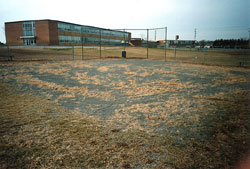 |
By the end of Grade 6, students will have spent 1,800 hours or 257 school days in their schoolyard. |
There are approximately 17,000 schools and over 7,000,000 schoolchildren from 4 to 18 years of age in Canada. Since the majority of schoolyards are barren, windswept rectangles of asphalt and grass, this means that huge numbers of young people are spending a lot of time in drab, uninteresting, inadequate surroundings that should be nurturing, life-enhancing, safe and equitable.
We are only just starting to plan school grounds with our children's health and happiness in mind. We are beginning to realize that when we design environments for children, we are really making environments that make the children. We are discovering that ugly, uncomfortable, unhealthy, uninteresting, uncaring, prison-like places generate negative behaviours and attitudes among children whereas spaces that respect their needs produce positive responses.
"Interestingly enough, both human and chimpanzee children are placed in an environment which is not "natural" but which has been structured for them. However, the environment created for the chimpanzee in captivity was planned with more science, art and attention to their needs and potential."
Aaron, D. and Winawer, B. Child's
Play: A Creative Approach to Playgrounds for Today's Children,
1965
Parallels can be drawn between children in the typical barren schoolyard and zoo animals exhibited in featureless enclosures. This design for high visibility ignores the animals' need for natural habitat, interesting activities and places to forage. Where several animals of the same species are penned together, it also limits their ability to make individual choices between interacting with the whole group or finding a quieter spot to be alone or with a smaller group.
Spaces designed without the animals' needs in mind results in hostile behaviour, boredom, unhappiness, sickness and premature death. Design that respects the animals' basic needs and closely replicates their natural habitat, decreases aggression, boredom and unhappiness. The animals are healthier and less quarrelsome. They live longer and breed more successfully in captivity.
Click to enlarge
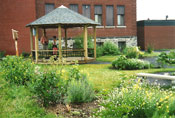
|
|
Likewise, when schools focus on transforming school grounds into a healthy, caring, living habitat for growing children, they transform the children's behaviour, attitude and sense of well-being.
Classrooms are the domain of educators because this is traditionally where most of the teaching has taken place in the past. The grounds are designed and managed by planners and engineers who generally have little to do with education apart from providing spaces for organized sports.
There is a need for educators and planners to start finding some common ground in "outdoor classroom" concepts since school grounds can grow into a vital resource for hands-on learning.
[Back to top]
A school grounds research project entitled "Special Places; Special People" started in Britain in 1990 and took almost three years to complete. The research was driven by one main question: "Does the design of school grounds and the way they are managed influence children's attitudes and behaviours?". After interviewing thousands of children across the country, the short answer to this question was an unequivocal "yes!".
Click to enlarge
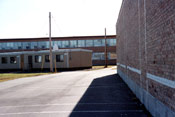 |
During an event held by the Canadian Biodiversity Institute to mark the launch of an urban school's grounds transformation project, a group of children were worried about whether they would still be allowed to go out in the yard "when it was nice and green".
Children, it seems, are taught by the environments we design for them, and in which they spend so many years, that they do not deserve anything better than bare expanses of asphalt and grass.
[Back to top]
The typical schoolyard offers space for letting off steam, and for very little else.
Empty rectangles of hard surfaces and grass give children the impression that all they are supposed to do outside is to rush around chasing each other and playing games that largely depend on commandeering and defending territory. And this is what they do simply because there is nothing else to do.
There is abundant evidence that the typical schoolyard design which emphasizes surveillance and active sports is one of the main causes of conflict among children. Large areas of the grounds are often monopolized by a relatively small number of children kicking a ball around. Children who do not move to the margins of the yard risk being kicked, knocked down or hit by the ball.
"Knock and bump" accidents are often the result of clashes between active and passive play. This frequently results in subdividing the yard into separate spaces for each age group. The problem is not necessarily solved by creating these subdivisions because active and passive play still take place in each section. In fact, other problems can then arise such as children becoming upset by being prevented from playing with friends or siblings who are confined to different areas. In addition, children often complain about the inequitable share of play equipment between grades which can happen when the yard is subdivided after its installation. This makes the children with fewer play options feel unimportant and neglected; it can also breed resentment between different age groups.
"The kindergartens and primary kids now have all the stuff and the juniors and big kids have nothing."
The unsuitable placement of things as simple as benches and storage sheds also causes problems:
Click to enlarge
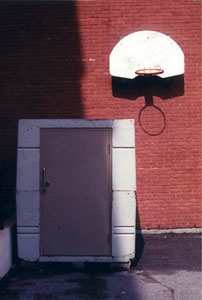 |
"They put things in strange places. Like the benches. Our only bench is right behind the soccer goal so you just get hit by a ball if you sit there. Then kids fight about it. The bench is useless for sitting on. Nobody can use it, so there's no point in having it."
"They put a metal bench in the middle of the field. There's no shade there and in the Summer it gets so hot that it burns our bottoms when we try to sit on it."
"They put the concrete storage shed right next to the basket ball hoop. It is in the way when we're playing. We run into it and hurt ourselves and balls get stuck on top of it. They don't think about us."
[Back to top]
Click to enlarge
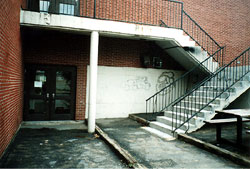 |
Children notice everything in their schoolyard. In their view, signs of neglect such as cracked paving, rusted and broken fences, sagging gates, peeling paint, bent basketball hoops, clogged drains, worn-out grass, litter and graffiti and the lack of colour, shelter and comfort, all indicate adults' lack of care for them. They come to believe that they are not worth anything better.
Click to enlarge
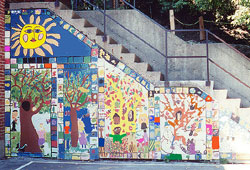 |
They want to have unsightly views and ugly, "o-fence-ive" fences screened with vines, shrubs and trees and ask for swings, tires, tunnels and simple but challenging climbing apparatus. They want "nice" wildlife instead of the scavengers such as gulls, starlings, sparrows, pigeons and wasps that are attracted by food waste and sugary residues on pop cans, drink boxes and candy wrappers. Above all, they want to participate in making the changes.
Children are often angry and resentful because it is obvious to them that adults have not designed the outdoor spaces with their interests and needs in mind. Children's needs and preferences can only be determined by consulting with them. This is why children must be involved right from the start in any school grounds greening project.
[Back to top]
Click to enlarge
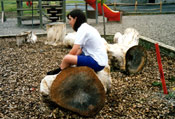 |
Schools and communities can take action now to support the civic and legal rights of children and youth!
In 1997, all but three of the world's nations ratified the Convention on the Rights of the Child and legally bound themselves to its provisions, which include participation clauses to the effect that "children have a right to express their views on all matters that concern them, to freely seek and impart information, and to assemble peacefully".
It recognizes children and youth as a major group who must be involved in shaping and caring for the natural and urban environment. Children around the world have indicated that they want to be involved in creating places that are "green, safe, secure, healthy, clean, active and livable for people of all ages".
The Convention states that participating in decisions that affect their lives, including decisions about the shape and form of their living environment, is a "civil right to which children are entitled as well as adults". It is also a legal right that cannot be diminished or dismissed on the pretext that "adults know best what children need".
It is generally assumed by adults that if material provisions have been made for children's basic needs, schools have been built, and a few play spaces have been added, then children have been provided for. However, it has been demonstrated that, after their basic needs have been met, what matters most to young people has less to do with material qualities and more to do with being respected and integrated into the community's social and cultural life. They want to have an active, friendly public life with meeting places and green spaces they can call their own and places for both organized and creative play.
In theory, adults have little trouble recognizing the value of giving children and youth the right to participate in improving their environments. In practice, however, they have difficulty relinquishing control, acting as facilitators, and allowing projects to be driven by young people because they still believe that "adults know best what children need".
Judging from what children and youth have to say about the design of the typical schoolyard, it is clear that we do not know what they need. There is no better way of rethinking our assumptions than to consult with the "clients" themselves, listen carefully to their comments and suggestions, and involve them in reshaping and caring for their school grounds.
|

"If children were unionized they would surely organize walkouts
and strikes against such atrocious working conditions. The fact that
they are still prevalent in the majority of schools, where
supposedly children should learn understanding and respect for their
surroundings, is a measure of adults' disregard for children's basic
right to a safe environment, and one that is life-enhancing and
developmentally-supportive."
Robin Moore -
Before and After Asphalt: Diversity as an Ecological Measure of
Quality in Children's Outdoor Environments |
[Back to top]
Employers have discovered the benefits of transforming the workplace. By improving indoor air quality and adding plants, colour, artwork, comfortable office furniture, social spaces, showers and lockers, employers have helped decrease stress-related absenteeism and illness and increase productivity, company loyalty and a sense of well-being among employees.
Schools that have improved the outdoor "schoolplace" report similar positive changes.
As a way of looking at the "schoolplace" from a new perspective, adults might start by asking themselves if they would be prepared to tolerate in their own workplace the kinds of conditions in which their children are placed.
[Back to top]
Play Structures
Click to enlarge
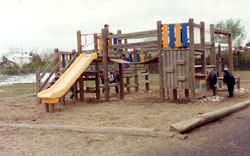
|
|
Is the play structure that has come to dominate children's play spaces everywhere really worth all the time, effort and expense?
The newly-updated (1998) CSA safety standards have caused the removal of a great number of schoolyard play structures. Schools now have the opportunity to reevaluate their play value.
Click to enlarge
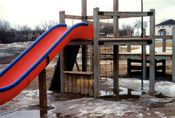 |
|
Although play structures can be a good form of activity for some children some of the time, they do not suit all of the children at all stages of their development. Many children say they that playing on the same giant "toy" every day for years is boring and even describe play structures as "ugly, insulting and offensive". Most children want to have a greater diversity of choices to suit their changing developmental needs.
| |
Click to enlarge
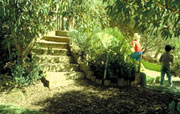
| Photo: |
Robin Moore & Susan Goltsman,
Play for All |
|
|
The research project, Special Places; Special People, concluded that "fixed play equipment was symbolic for the children of a recognition by the school of some of the children's play needs.
However, the equipment itself often failed to meet these needs. Generally, the most popular equipment was that which allowed children to adapt it, to make new meanings around it and subvert or change its apparent intention. The greater the potential of the equipment to be changed or manipulated the better."
To help ensure that play equipment will meet children's play needs, it is important for adults to think about alternative play and social options and to consult with children before planning to purchase new play equipment.
"When children are consulted in a meaningful way about the provision of equipment and participate in implementing other changes to improve the quality of the grounds in general, the equipment provided holds the greatest value."
Wendy Titman,
Special Places; Special People: The Hidden Curriculum of School Grounds, 1994
Click to enlarge
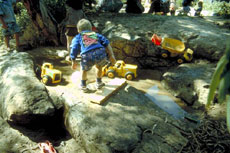
| Photo: |
Robin Moore & Susan Goltsman,
Play for All |
|
It is apparent from children's comments that although they find some play structures interesting during their earlier years in school, they soon grow bored with them and physically outgrow them. The vast majority of children are much more excited by the idea of creating an "activity trail" where climbing bars and nets, slides, fire poles, tunnels, bridges, sand boxes, teeter-totters, play houses, water play areas, and fitness and obstacle course activities are spread out along a trail.
Click to enlarge
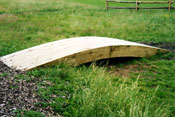 |
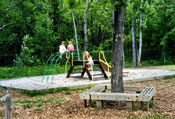 |
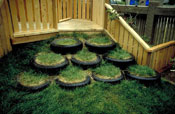
| Photo: |
Robin Moore & Susan Goltsman,
Play for All |
|
[Back to top]
Today's classroom, unlike the traditional kind with its rows of desks, is usually bright and cheerful with activity centres and individual and group spaces designed to address the needs of learners.
Educators have long recognized the value of modifying classroom design; however, the importance of the outdoor spaces to children's education and social, spiritual and emotional health has rarely been questioned.
Children do not stop learning when they go outside to play. We need to stop and consider what children are learning about our level of care for them when we plan schoolyards that are in many children's view `boring, dull, ugly, hard-edged, unsafe, prison-like, uncomfortable and dirty'.
Click to enlarge
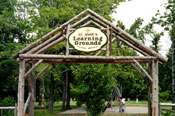 |
|
[Back to top]
Responsible citizens in the making
Click to enlarge
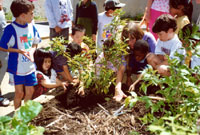
Photo: Heather Hamilton |
If young people are expected to develop into citizens who will take responsibility for the quality of their environments, they must have opportunities to participate in, and learn from all aspects of ecological and community restoration projects from an early age.
The best place to start
Click to enlarge
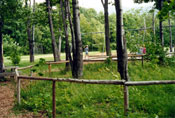 |
There is no better place for young people to start contributing to environmental health than on their school grounds. It is their space and its quality profoundly affects the development of their sense of themselves, their sense of place and their sense of belonging to a place. It is a place where they can learn to cooperate with others, connect with the natural world and start taking on the responsibility of caring for the health of their communities and the environment.
Click to enlarge
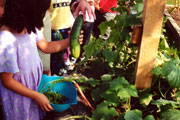 |
|
"Early childhood and elementary education might very well begin and be developed in a gardening context. How much children could learn! A language related to life...emotional responses to blossoming and fruitful plants...social cooperation...death as a source of life. They could learn geology, biology and astronomy; they could learn the sources of poetry, literature and the arts."
Father Thomas
Berry, The Sextant, October, 1999 [Back to top]
|